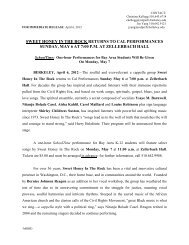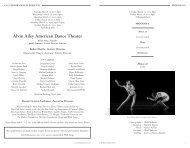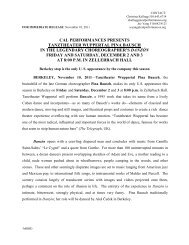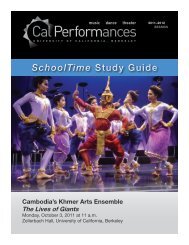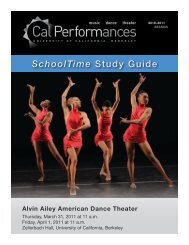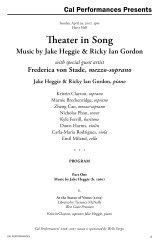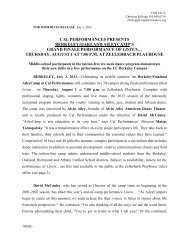Alvin Ailey American Dance Theater - Cal Performances - University ...
Alvin Ailey American Dance Theater - Cal Performances - University ...
Alvin Ailey American Dance Theater - Cal Performances - University ...
Create successful ePaper yourself
Turn your PDF publications into a flip-book with our unique Google optimized e-Paper software.
Costumes: Colors Have Meanings<br />
You will see that the color scheme for<br />
the costumes is different in each section<br />
of Revelations. In “Pilgrim of Sorrow,” the<br />
dancers wear earth-toned costumes; in “Take<br />
Me to the Water,” the costumes are white; and<br />
in “Move, Members, Move,” the dancers wear<br />
yellow. After the performance, discuss why<br />
<strong>Ailey</strong> might have chosen these colors.<br />
Props Tell a Story<br />
In Revelations, the dancers use props to<br />
help bring <strong>Ailey</strong>’s childhood memories to life.<br />
Watch for:<br />
• Long sheets of blue and white fabric<br />
stretched across the stage to suggest water<br />
• White parasols, wide-brimmed hats, and<br />
fans to imply the heat of Texas summers<br />
• Stools used by the dancers to represent<br />
a seated church congregation<br />
How Lighting Creates Mood<br />
Revelations begins with a group of<br />
dancers standing under a single spotlight on<br />
a darkened stage. Later, the dancers move<br />
across a fully illuminated stage. After the<br />
performance, consider how these and other<br />
lighting effects were used to create different<br />
moods.<br />
Moving to Music<br />
The dancers in Revelations<br />
move to the sound of African-<strong>American</strong><br />
spirituals.<br />
Listen for these<br />
lines from the songs:<br />
“There is trouble all over this<br />
world.”<br />
“Wade in the water.”<br />
“Oh sinner man, where you gonna run to?”<br />
After the performance, discuss how the<br />
dancers’ movements related to these words.<br />
Modern <strong>Dance</strong><br />
Modern dance was developed in America<br />
nearly 100 years ago as a reaction against<br />
the rules and structure of ballet. While ballet<br />
dancers strive to appear weightless, modern<br />
dancers embrace gravity. The following<br />
information outlines the basic differences<br />
between modern dance and ballet. During<br />
the performance, watch for movements that<br />
represent either modern dance or ballet.<br />
Modern <strong>Dance</strong><br />
• Methods and choreographic styles<br />
are more personal; may include everyday<br />
movements such as walking, skipping, running,<br />
and falling<br />
• Builds on modified versions of ballet<br />
positions; also uses as many positions as the<br />
choreographer can imagine<br />
• Upper body is loose and fluid<br />
• Sometimes uses asymmetrical, or not<br />
identical, patterns and designs<br />
• <strong>Dance</strong>rs usually perform in bare feet to<br />
maintain a closer connection to the floor<br />
• Acknowledges and uses gravity<br />
Classical Ballet<br />
• Based on accepted steps, movements, and<br />
traditions that go back hundreds of years<br />
• Uses five basic positions of the feet and<br />
arms<br />
• Upper body is held stiff and upright<br />
• Based on symmetrical, or identical,<br />
corresponding patterns and designs<br />
• <strong>Dance</strong>rs wear ballet slippers or pointe<br />
shoes<br />
• Airborne, tries to defy laws of gravity<br />
SchoolTime <strong>Alvin</strong> <strong>Ailey</strong> <strong>American</strong> <strong>Dance</strong> <strong>Theater</strong> | 25



